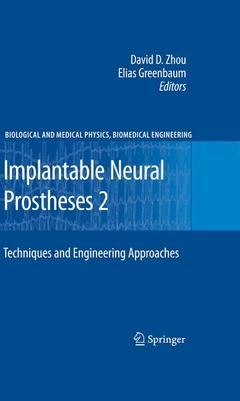Implantable Neural Prostheses 2, 2010 Techniques and Engineering Approaches Biological and Medical Physics, Biomedical Engineering Series
Langue : Anglais
Coordonnateurs : Zhou David, Greenbaum Elias

Signi?cant progress has been made in the development of neural prostheses for restoration of human functions and improvement of the quality of life. Biomedical engineers and neuroscientists around the world are working to improve the design and performance of existing devices and to develop novel devices for arti?cial vision, arti?cial limbs, and brain-machine interfaces. This book, Implantable Neural Prostheses 2: Techniques and Engineering Approaches, is part two of a two-volume sequence that describes state-of-the-art advances in techniques associated with implantable neural prosthetic devices. The techniques covered include biocompatibility and biostability, hermetic packaging, electrochemical techniques for neural stimulation applications, novel electrode materials and testing, thin-?lm ?exible microelectrode arrays, in situ char- terization of microelectrode arrays, chip-size thin-?lm device encapsulation, microchip-embedded capacitors and microelectronics for recording, stimulation, and wireless telemetry. The design process in the development of medical devices is also discussed. Advances in biomedical engineering, microfabrication technology, and neu- science have led to improved medical-device designs and novel functions. However, many challenges remain. This book focuses on the engineering approaches, R&D advances, and technical challenges of medical implants from an engineering p- spective. We are grateful to leading researchers from academic institutes, national laboratories, as well as design engineers and professionals from the medical device industry who have contributed to the book. Part one of this series covers designs of implantable neural prosthetic devices and their clinical applications.
The Biocompatibility and Biostability of New Cardiovascular Materials and Devices.- Technology Advances and Challenges in Hermetic Packaging for Implantable Medical Devices.- Science and Technology of Bio-Inert Thin Films as Hermetic-Encapsulating Coatings for Implantable Biomedical Devices: Application to Implantable Microchip in the Eye for the Artificial Retina.- The Electrochemistry of Charge Injection at the Electrode/Tissue Interface.- In Situ Characterization of Stimulating Microelectrode Arrays: Study of an Idealized Structure Based on Argus II Retinal implants.- Thin-Film Microelectrode Arrays for Biomedical Applications.- Stimulation Electrode Materials and Electrochemical Testing Methods.- Conducting Polymers in Neural Stimulation Applications.- Microelectronics of Recording, Stimulation, and Wireless Telemetry for Neuroprosthetics: Design and Optimization.- Microchip-Embedded Capacitors for Implantable Neural Stimulators.- An Effective Design Process for the Successful Development of Medical Devices.
Describes basic techniques and engineering approaches for the design of implantable neural prosthetic devices Covers topics from biocompatibility to microelectronics, packaging, and recording techniques Addresses a broad audience of materials scientists, engineers, clinicians, and students Includes supplementary material: sn.pub/extras
Date de parution : 02-2012
Ouvrage de 371 p.
15.5x23.5 cm
Date de parution : 10-2009
Ouvrage de 371 p.
15.5x23.5 cm
Thèmes d’Implantable Neural Prostheses 2 :
© 2024 LAVOISIER S.A.S.



